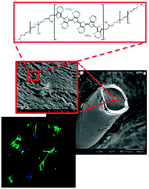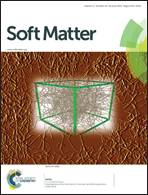Elastomeric and soft conducting microwires for implantable neural interfaces†
Abstract
Current designs for microelectrodes used for interfacing with the nervous system elicit a characteristic inflammatory response that leads to scar tissue encapsulation, electrical insulation of the electrode from the tissue and ultimately failure. Traditionally, relatively stiff materials like tungsten and silicon are employed which have mechanical properties several orders of magnitude different from neural tissue. This mechanical mismatch is thought to be a major cause of chronic inflammation and degeneration around the device. In an effort to minimize the disparity between neural interface devices and the brain, novel soft electrodes consisting of elastomers and intrinsically conducting polymers were fabricated. The physical, mechanical and electrochemical properties of these materials were extensively characterized to identify the formulations with the optimal combination of parameters including Young's modulus, elongation at break, ultimate tensile strength, conductivity, impedance and surface charge injection. Our final electrode has a Young's modulus of 974 kPa which is five orders of magnitude lower than tungsten and significantly lower than other polymer-based neural electrode materials. In vitro cell culture experiments demonstrated the favorable interaction between these soft materials and neurons, astrocytes and microglia, with higher neuronal attachment and a two-fold reduction in inflammatory microglia attachment on soft devices compared to stiff controls. Surface immobilization of neuronal adhesion proteins on these microwires further improved the cellular response. Finally, in vivo electrophysiology demonstrated the functionality of the elastomeric electrodes in recording single unit activity in the rodent visual cortex. The results presented provide initial evidence in support of the use of soft materials in neural interface applications.


 Please wait while we load your content...
Please wait while we load your content...